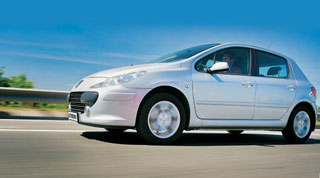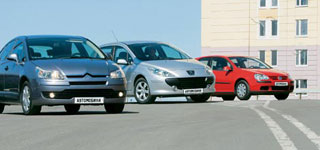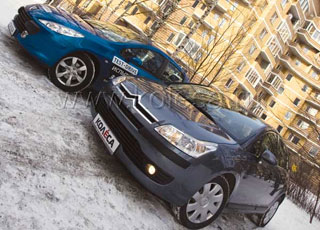PEUGEOT 307 Test drive 5 doors 2005 - 2008 hatchback
Facelft
The face of the updated Peugeot 307 was pulled to new corporate standards. Restyling, or, as it is also called, Feyslift, differs from the change of generations that this operation is purely cosmetic, not involving revolutionary changes, but only designed to slightly refresh the model before the next stage of its conveyor life. Not a revolution, but evolution. What we were convinced by getting acquainted with the three most striking representatives of the updated Peugeot 307 line-SS Cabilet Capriolet, SW universal and hatchback in the luxurious FELINE.The market debut of the updated Peugeot 307 is unlikely to pass as violently as in the summer of 2001, when each appearance of the 307th on the capital's streets was invariably accompanied by an explosion of emotions. One bright, sharply knocking out of the Peugeot model row came to taste, others - including the owners of the 306s - sincerely perplexed how the French decided on such revolutionary changes. Someone, having seen the traits of competitors-classmates in the guise of a model-Peugeot 307 even called a golfoid, openly accused the creators of plagiarism ...
The time, as usual, set everyone in place. Since 2001, 2.2 million 307s of different modifications have been produced, and the most popular is a five-door hatchback, which accounts for 48% of all sales. Every day in four factories, 2210 cars are produced, including the sedan gathers in China exclusively for the local market.
However, a chubby, almost single -volume hatchback today will not surprise anyone - a tendency. The appearance of the 307th is no longer captivated by extravagance. Yes, and in the Koshachi family, noticeable changes occurred: 407th, which proclaimed a new corporate style, which was a hypertrophied false radiator grille, entered the market. In this vein, it was decided to transform the appearance of the Peugeot 307. Add to the aggressive grin of the air intake even more deflected by the predecessor of the squint of the head optics, under the LEDs made of the rear lights, the clumsy moldings on the front bumper and the rounded fog lights are just as doubtfully fit into the image - And here he is, our hero. But this is cosmetics. And what is offered besides the retired appearance?
Of course, the interior did not go unnoticed. This is especially noticeable in the most expensive versions. For example, a leather salon now means not only seats and upholstery, but also torpedo. The climatic system has become separate. The list of optional equipment was replenished with free hands with the Bluetooth interface. The system of assistance in parking was improved: a visual image was added to the sound signals (the contour of the car indicating the distance to the obstacle) displayed to the multifunctional display ...
In addition to the expanded list of basic and pre-equipment for the entire line of the 307th model, we note the traces of the update inherent in individual modifications. So, the SW luxury station wagon received a completely glass roof (before glazing was only part of it) a la 407 SW. In addition, the salon is distinguished by wide transformation capabilities. Each of the three individual seats of the second row, if necessary, can be moved, folded or completely removed from the car. In the SW base, five -seater (such a car visited the test), but by order it is equipped with two additional chairs placed in the luggage compartment.
The back seat of the hatchback is also quite spacious. Even sitting behind a tall driver, a person is by no means a subtile complexes feels quite comfortable: from the knees to the back of the front seat there is a good twenty centimeters. It does not press the high ceiling. True, the three of them will still be crowded at the back. The place in the middle is better to give in to the abducting boxing box.
But in the Coupe -Kabriolet the fourth passenger has nothing to do: in the second row - only two chairs. True, not everyone will be able to conveniently sit in them, but in honor to say, it is better to give back places to children. The trunk of 307 CC does not indulge in the open spaces, the lion's share of the useful space in which the hard roof is eating there. Not the most practical car, in general. But how nice it is to remove the top and leisurely ride through the evening streets, catching enthusiastic glances ...
By the way, about driving. It's time to talk about how the updated 307th behave on the road. But first - a few words about modernized power units. Recall that in 2001, Russian clients offered three options for gasoline engines: 1.4 liters (75 hp), 1.6 l (110 hp) and 2 l (137 hp). Little of updated cars remained the same. True, power was added to the engines: 1.4-liter now develops 90 hp, and the basic 2-liter version is 140 hp. (1.6-liter unit remained unchanged). The choice of transmission also remained the same-a 5-speed mechanics or a 4-band machine with the possibility of choosing gearboxes manually (only 110- and 140-horsepower engines are aggregated with an automatic box).
The most serious modernization, which affected almost all systems, has undergone a former 137-horsepower engine. As a result, the engine not only added in power, but also became more moment (200 Nm at 4000 rpm against the previous 190 nm at 4100 rpm), and 92% of the maximum torque is reached at 2500 rpm. The acceptance at low speeds has improved, the noise and fuel consumption decreased.
At the top of the line, the 2-liter 180-horsepower modification settled-the most powerful of the four-cylinder Peugeot engines, installed only on sports versions: three- and five-door hatchbacks and a capricious coupe. From this wonderful unit (under the hood of Peugeot 307 SS) and our acquaintance with the updated line of the 307th model began.
A sharp acceleration in the second gear, and the convertible literally shoots, in one fell swoop, catching up with the departed colleagues. The third, fourth (gear shift mechanism was very pleased with lightness and accuracy). And we did not have time to use the fifth - we rested on the cork. Yes, metropolitan streets clogged with transport are not the best place to evaluate the driving characteristics of the car (and, by the way, it is better to return the roof to the place, at the same time activating the recirculation mode in the climate system). The lulling series of smooth overclocking and braking relaxes. But then it seemed to be resolved - we give gas and ... at the next moment, the stop -signals of the front car flashed a warningly, and our Peugeot froze in place, clinging tightly into the asphalt with all four wheels. Disc brakes helped to avoid unplanned airbags (by the way, already in the base of them) (for versions with a top-motor, the diameter of the ventilated front disks is increased to 302 mm). By the way, all versions of Peugeot 307 are equipped with ABS with an electronic brake regulation system (Ref), which distributes pressure in the brake cylinders.
As it turned out on the winding regional tracks, vigilant electronics in the person of the optional stability system insures the driver in dangerous turns. However, an experienced driver can easily cope with the skid and without her help: the updated 307th retained excellent controllability. Sently responding to the work by the steering wheel (the force on the steering wheel changes depending on the speed of movement, the angular speed of rotation of the steering wheel and the temperature of the working fluid of the electro -hydraulic amplifier), Peugeot gracefully missed any road rubbish. However, having missed a couple of potholes in the asphalt, you are again convinced that you have to pay with comfort for handling: the suspension reacted much tougher than I would like. Alas, the chassis (in front is a variation on the theme of the classic Mcphereson, behind - deformed beam) restyling did not seem to affect.
Note that in terms of smoothness, a heavy and soft coupe -battery is favorably different from the hatchback - we recommend overcoming obstacles like bedridge or tram rails on a five -door version with double caution. But it is more pleasant to control the powerful hatchback: due to a smaller mass, the car is more alive to work an accelerator, and a more rigid body definitely makes the car sharper.
By the way, the tandem of the 180-horsepower engine and 5-speed mechanics most clearly proved himself to be on the hatchback. The unit pleased with balance and elasticity, providing quite decent traction on the bottoms and acceptable acceleration from relatively small speeds even in the fifth gear.
However, the 140-horsepower Peugeot 307 SW with an automatic gearbox did not look like an outcast in the company of athletes. The machine, of course, is not the most modern (according to the current standards, four ranges are frankly not enough), but adaptive. And - not without reason the word Porsche appears in the name of the transmission - it is quite possible to train a box of active manner of riding. It takes about half an hour. If there is no desire to wait, immediately press the Sport button to the left of the selector. In sports mode, the machine is in no hurry to switch to increased gears, allowing you to fully realize the potential of the engine. (There is another special mode - winter, to move on the snow not with the first, but from the second gear, avoiding slipping.) But manual control did not please: the machine, as if endowed with the instinct of self -preservation, independently switches up with the slightest hint of the engine twisting. Active braking by the engine when reducing speed, on the contrary, does not occur: the box resumes the transmission, more precisely, drops to the first only when the car is stopped. In general, as it seemed to us, it is better to leave the selector in the Drive position and not to indulge in the sequential mode ...
Summing up the results of this express test, you can only complain that the most popular 1.6-liter hatchback remained beyond its framework (however, the restyling of this version has not brought anything in the renewed appearance and expanded list of options). The appearance, of course, is controversial. Although she, I think, will quickly get used to it. And the current 307th is really rich. That's only at the time of the market debut of the 307th, depending on the engine and the level of configuration, they asked $ 12,900- $ 18,800. Today, $ 16,600 must pay for the most affordable car (3-door hatchback with a 1.4-liter engine. A 5-door hatchback with a 2-liter 180-horsepower engine in the most expensive version of FELINE-$ 32,000.
Text: Andrey Tsybulsky
Source: Mkobil magazine [31.10.2005]








